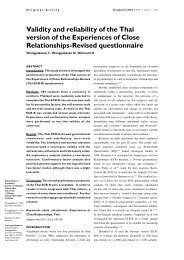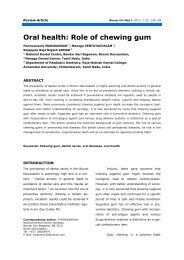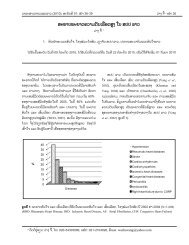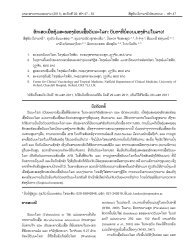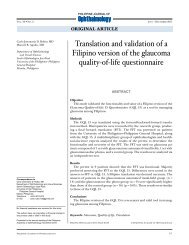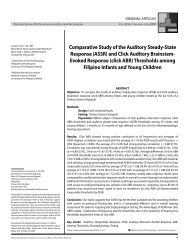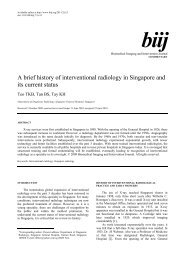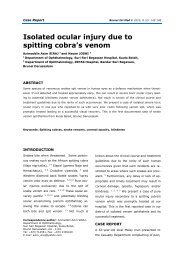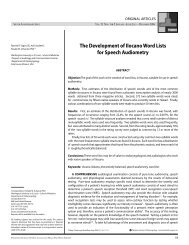Arterial vascularisation of the anterior perforated ... - APAMED Central
Arterial vascularisation of the anterior perforated ... - APAMED Central
Arterial vascularisation of the anterior perforated ... - APAMED Central
Create successful ePaper yourself
Turn your PDF publications into a flip-book with our unique Google optimized e-Paper software.
as <strong>the</strong> course and number <strong>of</strong> LLAs arising from <strong>the</strong>m have<br />
practical application in transsylvian approaches, which<br />
require exposure <strong>of</strong> part or all <strong>of</strong> <strong>the</strong> insula. (11,12)<br />
Chyatte and Porterfield reported that LLAs arising<br />
from <strong>the</strong> M1 trunk never supply <strong>the</strong> frontal lobe, and<br />
<strong>the</strong>refore, it is easier to retract <strong>the</strong> frontal lobe away from<br />
<strong>the</strong> MCA during surgery. (13) Moreover, Tanrıover et al<br />
also reported in <strong>the</strong>ir study that an early frontal branch<br />
arising from <strong>the</strong> M1 segment may exist in more than 30%<br />
<strong>of</strong> cases, and on average, this gives rise to more LLAs per<br />
vessel than <strong>the</strong> early temporal branch. They also added<br />
that if a large, proximal early frontal branch is seen to<br />
give rise to several LLAs on an angiogram, consideration<br />
should be given to <strong>the</strong> initial retraction <strong>of</strong> <strong>the</strong> temporal<br />
lobe ra<strong>the</strong>r than <strong>the</strong> frontal lobe, away from <strong>the</strong> MCA. (10)<br />
Hence, surgeons must be aware <strong>of</strong> <strong>the</strong> possibility <strong>of</strong> such a<br />
situation arising during surgery. Türe et al recorded LLAs<br />
originating from <strong>the</strong> superior or inferior trunk <strong>of</strong> <strong>the</strong> M2<br />
segment, which are located near <strong>the</strong> main bifurcation <strong>of</strong><br />
<strong>the</strong> MCA, in three (7.5%) hemispheres. (1) However, we<br />
observed that <strong>the</strong> LLAs originated from <strong>the</strong> superior<br />
trunk <strong>of</strong> <strong>the</strong> MCA in only two (3.3%) hemispheres, but<br />
none from <strong>the</strong> inferior trunk. In addition, it has been noted<br />
that <strong>the</strong> LLAs usually arise from <strong>the</strong> pre-bifurcation trunk<br />
<strong>of</strong> <strong>the</strong> MCA in previous studies, and our results were<br />
concordant with this finding. (1,11,12)<br />
The LLAs that penetrate <strong>the</strong> APS play an important<br />
role in <strong>the</strong> supply <strong>of</strong> blood to <strong>the</strong> internal capsule,<br />
putamen, caudate nucleus and globus pallidus. (1,14) The<br />
APS lies just medial to <strong>the</strong> limen insulae and serves as<br />
an important surgical landmark. In <strong>the</strong>ir study, Tanrıover<br />
et al considered <strong>the</strong> point <strong>of</strong> entrance <strong>of</strong> <strong>the</strong> most lateral<br />
LLA to be <strong>the</strong> lateral limit <strong>of</strong> <strong>the</strong> APS, and referred to it<br />
as <strong>the</strong> “limen recess”, which is between <strong>the</strong> medial border<br />
<strong>of</strong> <strong>the</strong> limen insulae and <strong>the</strong> point <strong>of</strong> entrance <strong>of</strong> <strong>the</strong> most<br />
lateral LLA. (15) The limen recess is devoid <strong>of</strong> important<br />
perforating arteries and may be used as <strong>the</strong> medial limit<br />
<strong>of</strong> dissection during insular tumour surgery. Thus, an<br />
awareness <strong>of</strong> <strong>the</strong> location <strong>of</strong> <strong>the</strong> most lateral LLA may be<br />
helpful during insular tumour surgery, as motor deficits,<br />
such as hemiparesis due to obliteration <strong>of</strong> <strong>the</strong>se perforating<br />
arteries, constitute a significant number <strong>of</strong> complications<br />
that occur following such surgeries. (15-17) It is well known<br />
that aneurysms on <strong>the</strong> MCA are not unusual. The orifices<br />
<strong>of</strong> LLAs can be affected by <strong>the</strong>se aneurysms, and thus, <strong>the</strong><br />
surgical procedures used for <strong>the</strong> treatment <strong>of</strong> aneurysms<br />
may damage <strong>the</strong> LLAs. (12,18)<br />
In our study, <strong>the</strong> <strong>anterior</strong> perforating arteries<br />
arose from <strong>the</strong> <strong>anterior</strong> choroidal artery in all 60<br />
hemispheres. However, Rosner et al noted that <strong>the</strong>se<br />
arteries arose from <strong>the</strong> main trunk or superior branch<br />
Singapore Med J 2011; 52(6) : 413<br />
<strong>of</strong> <strong>the</strong> <strong>anterior</strong> choroidal artery and enter <strong>the</strong> brain<br />
through <strong>the</strong> APS. In addition, <strong>the</strong>y also reported that<br />
<strong>the</strong> <strong>anterior</strong> perforating arteries arose from <strong>the</strong> ICA, (2)<br />
which differs from our findings. Previous studies have<br />
found that <strong>the</strong> arteries <strong>of</strong> APS originate from <strong>the</strong> A1<br />
or A2 segments <strong>of</strong> <strong>the</strong> ACA; (2,19,20) <strong>the</strong>se findings were<br />
also observed in our study. As mentioned earlier, like<br />
<strong>the</strong> LLAs that originate from <strong>the</strong> MCA, <strong>the</strong>se arteries<br />
have an important role to play in <strong>the</strong> supply <strong>of</strong> blood to<br />
some important internal structures such as <strong>the</strong> internal<br />
capsule or nuclei basales. (2,12,21)<br />
The accMCA usually originates from <strong>the</strong> ACA,<br />
particularly from its A1 or <strong>the</strong> proximal part <strong>of</strong> <strong>the</strong> A2<br />
segments, and courses parallel to <strong>the</strong> MCA. This artery<br />
supplies <strong>the</strong> orbit<strong>of</strong>rontal and prefrontal regions <strong>of</strong> <strong>the</strong><br />
territory <strong>of</strong> <strong>the</strong> MCA. (10,22,23) Knowledge <strong>of</strong> <strong>the</strong> accMCA<br />
is important for <strong>the</strong> surgical treatment <strong>of</strong> cerebral<br />
aneurysms and for understanding <strong>the</strong> collateral blood<br />
supply in cerebral ischaemia. (24,25) The incidence <strong>of</strong><br />
accMCA has been reported to be 0.4%–4% (approximately<br />
3%). (10-12,22,23) In our study, this variation was seen in two<br />
(3.3%) hemispheres. The perforating branches <strong>of</strong> <strong>the</strong><br />
accMCA to <strong>the</strong> APS have been mentioned in previous<br />
studies, (3,10,11,22,23,26) and this finding was observed<br />
in both cases <strong>of</strong> accMCA in our study. Therefore,<br />
when <strong>the</strong> accMCA appears as a variation, <strong>the</strong> high<br />
possibility <strong>of</strong> its branches perforating to <strong>the</strong> APS must<br />
be considered during surgery.<br />
In conclusion, this study highlights <strong>the</strong> complex<br />
arterial <strong>vascularisation</strong> <strong>of</strong> <strong>the</strong> APS. The arteries <strong>of</strong> APS<br />
are important due to <strong>the</strong>ir role in supplying blood to<br />
important structures such as <strong>the</strong> internal capsule, putamen,<br />
caudate nucleus and globus pallidus. Neurosurgeons must<br />
be aware <strong>of</strong> <strong>the</strong> importance <strong>of</strong> preserving <strong>the</strong>se arteries<br />
and should also keep in mind that damage to <strong>the</strong>se<br />
arteries during aneurysm or insular tumour surgery can<br />
cause serious motor complications such as dyskinesias,<br />
hemiparesis or hemiplagias.<br />
REFERENCES<br />
1. Türe U, Yaşargil MG, Al-Mefty O, Yaşargil DC. Arteries <strong>of</strong> <strong>the</strong><br />
insula. J Neurosurg 2000; 92:676-87.<br />
2. Rosner SS, Rhoton AL Jr, Ono M, Barry M. Microsurgical<br />
anatomy <strong>of</strong> <strong>the</strong> <strong>anterior</strong> perforating arteries. J Neurosurg 1984;<br />
61:468-85.<br />
3. Gibo H, Carver CC, Rhoton AL Jr, Lenkey C, Mitchell RJ.<br />
Microsurgical anatomy <strong>of</strong> <strong>the</strong> middle cerebral artery. J Neurosurg<br />
1981; 54:151-69.<br />
4. Fischer E. [Positional variations <strong>of</strong> <strong>the</strong> <strong>anterior</strong> cerebral artery<br />
in <strong>the</strong> vascular picture]. 1938; 3:300-12. German.<br />
5. Marinković SV, Kovacević MS, Marinković JM. Perforating<br />
branches <strong>of</strong> <strong>the</strong> middle cerebral artery. Microsurgical anatomy <strong>of</strong><br />
<strong>the</strong>ir extracerebral segments. J Neurosurg 1985; 63:266-71.<br />
6. Marinkovic SV, Milisavljevic MM, Kovacevic MS, Stevic ZD.<br />
Perforating branches <strong>of</strong> <strong>the</strong> middle cerebral artery. Microanatomy




